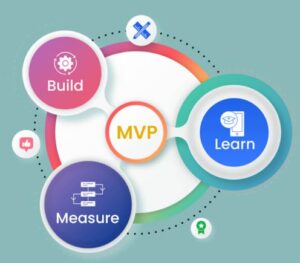What Is an MVP? In the realm of software development, an MVP, or Minimum Viable Product, serves as a pivotal launchpad for your project. Stripped to the essentials, an MVP incorporates core features, offering early adopters a glimpse of your unique product. It’s not just a prototype; it’s a tangible validation of your idea, setting […]
What Is an MVP?
In the realm of software development, an MVP, or Minimum Viable Product, serves as a pivotal launchpad for your project. Stripped to the essentials, an MVP incorporates core features, offering early adopters a glimpse of your unique product. It’s not just a prototype; it’s a tangible validation of your idea, setting the stage for future monetization strategies.

What Is an MVP?
Benefits That Beckon
Test for Success
Launching your MVP is like throwing your idea into the market arena. If it clears the success benchmarks, your concept gains validity, and you can expand its features confidently.
Test for Improvement
Feedback is the compass guiding your MVP journey. If users express concerns or dissatisfaction, use this data to enhance and reshape your MVP, ensuring it aligns better with market expectations.
Test for Failure
Discovering your MVP isn’t feasible early on is a blessing. It’s a cost-effective setback, preferable to investing in a full-fledged app without market assurance.
Crafting MVP Benefits
Early Feedback
Harness the power of feedback to understand user sentiments, preferences, and areas that need refinement. User input is the compass steering your product toward success.
Cost-Effectiveness
Building an MVP is an economical strategy, saving time and money. It’s a litmus test for your app’s acceptance, user-friendliness, and feature relevance, ensuring you tread the right path.
Possible Investments
A well-presented MVP becomes a magnet for investors. Showcase your product’s features, functionalities, and user feedback to attract crucial investments for further development.
Minimum Time to Market Release
Speed matters. Releasing a functional product early enables you to garner feedback, attract investors, and refine features swiftly. The MVP sets the stage for subsequent updates and improvements.
Real Market Conditions Testing
Validate your idea in the real market. The success or failure of your MVP provides invaluable insights, helping you decide whether to proceed with your vision.
Navigating MVP Development Costs

Navigating MVP Development Costs
Type and Complexity
From simple to high complexity, the nature of your MVP significantly influences development costs. Understand your project’s complexity to budget effectively.
Technology Selection
Choosing the right technology is pivotal. It affects development speed, costs, and overall success. Opt for platforms and languages that align with your project goals.
Time Investment
Time is money, especially in MVP development. Factors like product complexity and chosen technology stack directly impact the time required, influencing the budget.
Development Team Choice
Selecting the right development team is critical. Whether in-house, freelance, or a specialized agency, each option has its pros and cons that impact costs.
Engagement Model
Choosing between fixed price and time and material engagement models affects predictability and scalability. Evaluate which model aligns with your startup’s early-stage needs.
Blueprint for MVP Development

Blueprint for MVP Development
Discovery
Initiate your MVP journey with a thorough discovery phase. Define goals, set timelines, choose technologies, and assemble your team for a solid foundation.
Design and Development
Blend aesthetics with functionality. Design and development teams collaborate to create an MVP that meets project requirements, ensuring both visual appeal and code integrity.
Testing and Deployment
Quality assurance is paramount. Rigorous testing precedes deployment, ensuring a flawless launch. Post-launch, the development team stays vigilant for bug fixes during the guarantee period.
Post-Launch Maintenance
Continued collaboration between the development team and the product owner ensures post-launch issues are addressed promptly. A sustainable approach keeps your software evolving.
Unveiling the Price Tag

MVP Development
Analysing user needs and prioritizing features streamline your MVP development costs. The average expense ranges from $25,000 to $40,000, emphasizing the importance of focusing on core functionality, starting with a basic design, and utilizing third-party modules.
Conclusion
Diving into the realm of MVP development is not just a strategic move; it’s a calculated journey towards success. The cost of building an MVP is not a one-size-fits-all equation; it’s a dynamic interplay of factors, from the type and complexity of your project to the technology chosen and the team you engage.
The benefits of crafting an MVP are undeniable. It’s a litmus test for your idea, allowing you to pivot and refine based on real user feedback. Whether your MVP succeeds, prompts improvements, or faces setbacks, each outcome is a valuable lesson, steering you towards a more market-ready product.
The roadmap to MVP success involves a well-defined process, from discovery to post-launch maintenance. Each phase contributes to the robustness of your product and ensures a sustainable approach to software development.
As you navigate the landscape of MVP development costs, remember that the key lies in effective cost management. Analyzing user needs, focusing on core functionality, and leveraging smart design choices can help keep your project within the average cost range of $25,000 to $40,000.
In the end, the journey of MVP development is not just about creating a product; it’s about understanding your audience, adapting to market dynamics, and embracing the iterative nature of success. So, if you’re ready to turn your vision into reality, embark on the MVP journey with confidence, knowing that each step brings you closer to a product that not only solves problems but also resonates with your target audience.